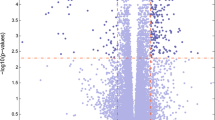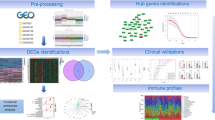Abstract
This study aimed to explore the underlying molecular mechanisms of idiopathic Parkinson’s disease (IPD) by bioinformatics analysis. Gene expression profile GSE34516 was downloaded from the Gene Expression Omnibus. Eight locus coeruleus post-mortem tissue samples derived from four IPD patients and four neurological healthy controls were used to identify the differentially expressed genes (DEGs) by paired t test. Based on the DEGs, principal components were analyzed. The Gene Ontology functional and Kyoto Encyclopedia of Genes and Genomes pathway analysis of the genome microarray data were then performed. Finally, protein–protein interaction (PPI) network of the DEGs was constructed. Total 261 DEGs including 195 up-regulated and 66 down-regulated DEGs were identified. Intracellular protein transport and RNA splicing via transesterification reactions were selected as the most two significantly enriched functions. Mismatch repair, N-glycan biosynthesis, spliceosome and nucleotide excision repair were the significantly enriched pathways. In the PPI network, CTSS, CD53, IGSF6, PTPRC and LAPTM5 were the hub nodes. Intracellular protein transport and RNA splicing via transesterification reactions were closely associated with IPD. The DEGs, such as CX3CR1, SLC5A7, CD53 and PTPRC may be the potential targets for IPD diagnosis and treatment.


Similar content being viewed by others
References
de Lau LM, Breteler M (2006) Epidemiology of Parkinson’s disease. Lancet Neurol 5:525–535
Hallett M (2012) Parkinson’s disease tremor: pathophysiology. Parkinsonism Relat Disord 18:S85–S86
Vistbakka J, VanDuyn N, Wong G, Nass R (2012) C. elegans as a genetic model system to identify Parkinson’s disease-associated therapeutic targets. CNS Neurol Disord Drug Targets (Formerly Current Drug Targets-CNS & Neurological Disorders) 11:957–964
Yoritaka A, Shimo Y, Takanashi M, Fukae J, Hatano T, Nakahara T, Miyamato N, Urabe T, Mori H, Hattori N (2013) Motor and non-motor symptoms of 1453 patients with Parkinson’s disease: prevalence and risks. Parkinsonism Relat Disord 19:725–731
Zweig R, Cardillo J, Cohen M, Giere S, Hedreen J (1993) The locus ceruleus and dementia in Parkinson’s disease. Neurology 43:986–991
Zecca L, Stroppolo A, Gatti A, Tampellini D, Toscani M, Gallorini M, Giaveri G, Arosio P, Santambrogio P, Fariello RG (2004) The role of iron and copper molecules in the neuronal vulnerability of locus coeruleus and substantia nigra during aging. Proc Natl Acad Sci USA 101:9843–9848
Gesi M, Soldani P, Giorgi F, Santinami A, Bonaccorsi I, Fornai F (2000) The role of the locus coeruleus in the development of Parkinson’s disease. Neurosci Biobehav Rev 24:655–668
Bernard R, Kerman IA, Thompson RC, Jones EG, Bunney WE, Barchas JD, Schatzberg AF, Myers RM, Akil H, Watson SJ (2011) Altered expression of glutamate signaling, growth factor, and glia genes in the locus coeruleus of patients with major depression. Mol Psychiatry 16:634–646
Lopez de Maturana R, Aguila JC, Sousa A, Vazquez N, del Rio P, Aiastui A, Gorostidi A, Lopez de Munain A, Sanchez-Pernaute R (2013) Leucine-rich repeat kinase 2 modulates cyclooxygenase 2 and the inflammatory response in idiopathic and genetic Parkinson’s disease. Neurobiol Aging. doi:10.1016/j.neurobiolaging.2013.11.018
Shin J-H, Ko HS, Kang H, Lee Y, Lee Y-I, Pletinkova O, Troconso JC, Dawson VL, Dawson TM (2011) PARIS (ZNF746) repression of PGC-1α contributes to neurodegeneration in Parkinson’s disease. Cell 144:689–702
Bäckman CM, Shan L, Zhang YJ, Hoffer BJ, Leonard S, Troncoso JC, Vonsatel P, Tomac AC (2006) Gene expression patterns for GDNF and its receptors in the human putamen affected by Parkinson’s disease: a real-time PCR study. Mol Cell Endocrinol 252:160–166
Waszczak BL, Wachtman L, Newsome GC, Aly A, Silva N, Westmoreland S, Rowlett J, Migliore MM (2013) Intranasal GDNF for Parkinson’s disease: next steps in preclinical development. FASEB J 27(1177):1110
Botta-Orfila T, Sànchez-Pla A, Fernández M, Carmona F, Ezquerra M, Tolosa E (2012) Brain transcriptome profiling in idiopathic and LRRK2-associated Parkinson’s disease. Brain Res 1466:152–157
Gautier L, Cope L, Bolstad BM, Irizarry RA (2004) Affy–analysis of Affymetrix GeneChip data at the probe level. Bioinformatics 20:307–315
Diboun I, Wernisch L, Orengo CA, Koltzenburg M (2006) Microarray analysis after RNA amplification can detect pronounced differences in gene expression using limma. BMC Genomics 7:252
Scott JG, Berger JO (2006) An exploration of aspects of Bayesian multiple testing. J Stat Plan Inference 136:2144–2162
Franceschini A, Szklarczyk D, Frankild S, Kuhn M, Simonovic M, Roth A, Lin J, Minguez P, Bork P, von Mering C (2013) STRING v9. 1: protein-protein interaction networks, with increased coverage and integration. Nucleic Acids Res 41:D808–D815
Smoot ME, Ono K, Ruscheinski J, Wang P-L, Ideker T (2011) Cytoscape 2.8: new features for data integration and network visualization. Bioinformatics 27:431–432
Junker BH, Koschützki D, Schreiber F (2006) Exploration of biological network centralities with CentiBiN. BMC Bioinform 7:219
Subramanian A, Tamayo P, Mootha VK, Mukherjee S, Ebert BL, Gillette MA, Paulovich A, Pomeroy SL, Golub TR, Lander ES (2005) Gene set enrichment analysis: a knowledge-based approach for interpreting genome-wide expression profiles. Proc Natl Acad Sci USA 102:15545–15550
Phani S, Loike JD, Przedborski S (2012) Neurodegeneration and inflammation in Parkinson’s disease. Parkinsonism Relat Disord 18:70064–70065
Shan S, Hong-Min T, Yi F, Jun-Peng G, Yue F, Yan-Hong T, Yun-Ke Y, Wen-Wei L, Xiang-Yu W, Jun M (2011) NEW evidences for fractalkine/CX3CL1 involved in substantia nigral microglial activation and behavioral changes in a rat model of Parkinson’s disease. Neurobiol Aging 32:443–458
Cardona AE, Pioro EP, Sasse ME, Kostenko V, Cardona SM, Dijkstra IM, Huang D, Kidd G, Dombrowski S, Dutta R, Lee JC, Cook DN, Jung S, Lira SA, Littman DR, Ransohoff RM (2006) Control of microglial neurotoxicity by the fractalkine receptor. Nat Neurosci 9:917–924. doi:10.1038/nn1715
Botta-Orfila T, Sanchez-Pla A, Fernandez M, Carmona F, Ezquerra M, Tolosa E (2012) Brain transcriptomic profiling in idiopathic and LRRK2-associated Parkinson’s disease. Brain Res 23:152–157
Nakata K, Okuda T, Misawa H (2004) Ultrastructural localization of high-affinity choline transporter in the rat neuromuscular junction: enrichment on synaptic vesicles. Synapse 53:53–56
Bazalakova M, Blakely R (2006) The high-affinity choline transporter: a critical protein for sustaining cholinergic signaling as revealed in studies of genetically altered mice. In: Neurotransmitter transporters, vol 175. Springer, Berlin, Heidelberg, pp 525–544
Dajas-Bailador F, Wonnacott S (2004) Nicotinic acetylcholine receptors and the regulation of neuronal signalling. Trends Pharmacol Sci 25:317–324
Quik M, McIntosh JM (2006) Striatal α6* nicotinic acetylcholine receptors: potential targets for Parkinson’s disease therapy. J Pharmacol Exp Ther 316:481–489
Calabresi P, Picconi B, Parnetti L, Di Filippo M (2006) A convergent model for cognitive dysfunctions in Parkinson’s disease: the critical dopamine–acetylcholine synaptic balance. Lancet Neurol 5:974–983
Amiot M (1990) Identification and analysis of cDNA clones encoding CD53. A pan-leukocyte antigen related to membrane transport proteins. J Immunol 145:4322–4325
Mourey RJ, Vega QC, Campbell JS, Wenderoth MP, Hauschka SD, Krebs EG, Dixon JE (1996) A novel cytoplasmic dual specificity protein tyrosine phosphatase implicated in muscle and neuronal differentiation. J Biol Chem 271:3795–3802
Tonks NK (2006) Protein tyrosine phosphatases: from genes, to function, to disease. Nat Rev Mol Cell Biol 7:833–846
Ahmed S, Santosh W, Kumar S, Christlet H (2009) Metabolic profiling of Parkinson’s disease: evidence of biomarker from gene expression analysis and rapid neural network detection. J Biomed Sci 16:63
Acknowledgments
We wish to express our warm thanks to the Fund supports from Shandong Province Natural Science Foundation of China (ZR2010CL018) and National Natural Science Fund (51273033, 81202502).
Author information
Authors and Affiliations
Corresponding author
Additional information
The Publisher and Editor retract this article in accordance with the recommendations of the Committee on Publication Ethics (COPE). After a thorough investigation we have strong reason to believe that the peer review process was compromised.
About this article
Cite this article
Cui, S., Sun, H., Gu, X. et al. RETRACTED ARTICLE: Gene expression profiling analysis of locus coeruleus in idiopathic Parkinson’s disease by bioinformatics. Neurol Sci 36, 97–102 (2015). https://doi.org/10.1007/s10072-014-1889-z
Received:
Accepted:
Published:
Issue Date:
DOI: https://doi.org/10.1007/s10072-014-1889-z




